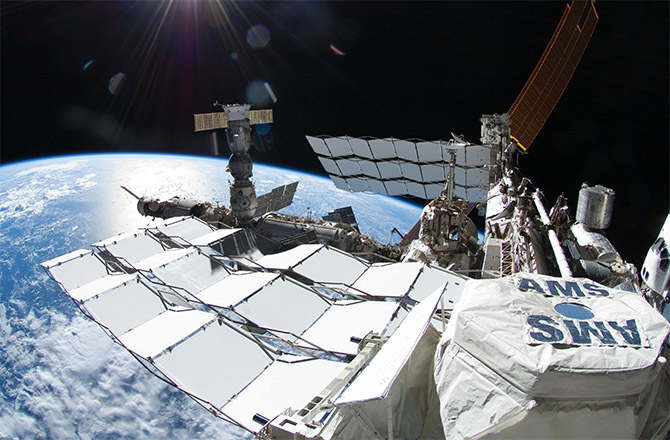Second Cosmic Ray Detector Delivered to Space Station

In addition to ferrying tons of food, water and supplies to the International Space Station, a Japanese cargo ship that arrived on Monday (Aug. 23) carried an astrophysics telescope that will join the flagship Alpha Magnetic Spectrometer in hunting for cosmic rays.
NEWS: Mystery Signal Could be Dark Matter Hint in ISS Detector
The Calorimetric Electron Telescope, or CALET, was due to be mounted on a platform outside Japan's Kibo laboratory on Tuesday (Aug. 24), joining the $2 billion AMS particle detector, which was attached to the station in 2011.
Once operational, CALET will precisely measure cosmic rays, at even higher energies than AMS.
"Cosmic rays come at you from all directions and all the time … Every time one of these high-energy cosmic rays comes at us and starts triggering the instrument, we record it," astrophysicist John Wefel, with Louisiana State University, said in a NASA TV interview.
NEWS: Dark Matter Mystery Deepens
Ground-based instruments can indirectly detect cosmic rays by measuring secondary particles that are created when the rays strike the atmosphere. By studying the cosmic rays directly in space, scientists hope to develop a better understanding of where they come from, what they are made of and how they come to have so much energy.
Get the Space.com Newsletter
Breaking space news, the latest updates on rocket launches, skywatching events and more!
The cosmic rays also may shed light on so-called "dark matter," which unlike regular matter does not emit detectable electromagnetic radiation. Dark matter, which comprises about 27 percent of the universe, can be indirectly detected by studying how its gravity influences nearby objects.
Regular matter adds up to less than 5 percent of the universe. The rest of the universe, roughly 68 percent, is filled with a mysterious anti-gravity force known as dark energy.
Top 10 Space Stories of the Decade
While AMS can detect electrons, protons, nuclei and antimatter at a range of energy levels, CALET is focused on high-energy electrons.
"CALET addresses many outstanding high-energy astrophysics questions such as the origin of cosmic rays, how cosmic ray accelerate and travel across the galaxy; and the existence of dark matter and nearby cosmic-ray sources," NASA said in a summary of the program.
The telescope, which will be mounted outside the station, is expected to operate for up to five years. A third astrophysics observatory, known as Cosmic Ray Energetics and Mass for the International Space Station, or ISS-CREAM, is due to launch next year.
This article was provided by Discovery News.
Join our Space Forums to keep talking space on the latest missions, night sky and more! And if you have a news tip, correction or comment, let us know at: community@space.com.

Irene Klotz is a founding member and long-time contributor to Space.com. She concurrently spent 25 years as a wire service reporter and freelance writer, specializing in space exploration, planetary science, astronomy and the search for life beyond Earth. A graduate of Northwestern University, Irene currently serves as Space Editor for Aviation Week & Space Technology.









